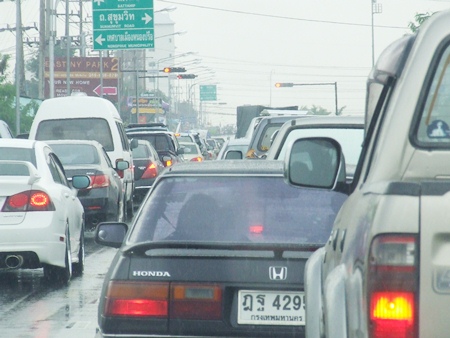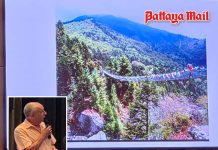Complaining about traffic in Pattaya is like complaining about the weather: It doesn’t get any better. Traffic, however, continues to worsen and perhaps government leaders need again to hear some constructive criticism as their attempts to solve congestion while continuing to grow the city have only made things worse.
What is the cause of area’s traffic woes? While there are a number of factors exacerbating gridlock, the underlying reality is the city’s network of sois and sais is simply too narrow for the city’s population.
Local, provincial and national government officials have attempted to alleviate pressure on the streets, but all their efforts have been failures. Why? Because even when one hand works to reduce traffic, the other hand feverishly offers development incentives for new hotels, shopping malls and tourists that only increase the number of people in town.

Pattaya City encompasses less than 50 sq. kilometers and had a registered population of only 107,406 people in April 2010. But the numbers lie. The non-registered Thai population is estimated to be as much as 500,000. Pattaya police officials estimate that during high season, the addition of tourists and a resident ex-pat population of about 150,000 people put Pattaya’s actual population closer to a million people.
At best, city density comes in at 2,000 people per sq. kilometer. More likely it’s ten times that.
Now add in the number of privately owned motorbikes and cars. Then add commercial and government vehicles; then tour buses and traffic vans. That’s already a lot of cars. Then you have the baht buses and, most recently, 100 meter taxis.
Pattaya’s Baht Bus Cooperative operates 700 “songthaews” in the city, most of which run empty or nearly so much of the time. When there’s a backup on Beach Road at night, you can blame the songthaews, which can be seen bogging down the left lane with long strings of empty trucks.
Empty trucks lead to irritated and idle drivers, who sometimes drink and often fight with tourists, besmirching the good image the city is trying to foster.
The biggest thing Pattaya could do to improve traffic congestion and its reputation would be to cut in half the number of baht buses. Traffic would flow faster, taxis would have higher occupancies and drivers would make more money. Everyone wins, except for the 350 drivers who’d have to find something more productive to do with their time.
City leaders, however, aren’t likely to ever cut the number of baht buses. If anything, they’ll keep increasing them. So, instead, the city installed 42 traffic lights with the stated goal of trying to improve pedestrian safety. It was an admirable goal as even infrequent visitors know those same baht buses are as likely to run down anyone using a zebra crossing as actually stop.
Someone made a windfall off the installation of those lights, as there are far too many spaced far too closely, some separated by just 100 meters, or less. And, as could have been predicted, the project has been, from Day One, an abject failure.
From the moment they were turned on, the lights were ignored by drivers and police largely refused to write tickets for blowing through them. Indeed, YouTube sports numerous videos of Pattaya Police and Tourist Police cars running the red lights.
Eventually, some people did start to heed the red lights, which created even more traffic. Badly timed and too close together, the signals ended up helping pedestrians by making traffic so slow along some roads that people could simply walk between stopped cars. Pattaya’s police eventually demanded the city simply turn off the lights on high-traffic weekends and holidays.
The city needs to yank out most of the lights and place them in other spots where they are actually needed. Then they need a better automated control system; not the same one that leads to interminable waits at Third Road intersections with Central and South roads. Signal placement and automated light systems are core ingredients of city planning.
Like Pattaya’s hot weather, its growth is not going to abate anytime soon. If city officials are genuinely serious about solving congestion, and not just shooting the breeze, they’ll tackle the two biggest factors slowing cars down: too many baht buses and poorly placed traffic signals.




